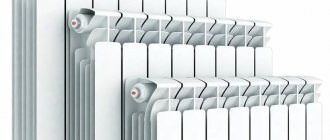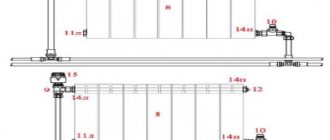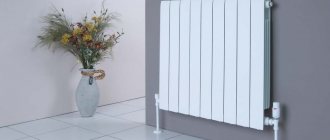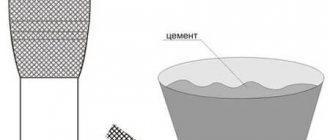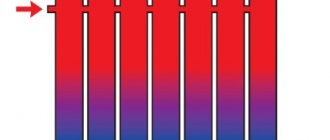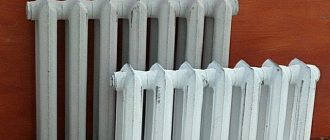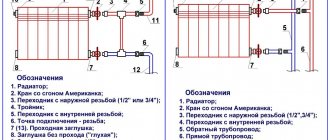Network connection
To independently connect to propylene pipes, you need to have a special soldering iron.
There are two connection options:
1. If the radiator valve is made of propylene, then its plastic pipe is connected by soldering directly to the connection. Then the American metal end is unscrewed from the tap and screwed into the radiator liner, using flax winding with paste or FUM tape to seal the connection. After which the “American” is reassembled and the union nut is tightened with a wrench.
2. If the radiator valve is metal, then to connect to the plastic liner use a combined detachable coupling with an internal thread. This coupling is similar in connection principle to the metal “American” one, but the union nut is located on a plastic solder end. The plastic part of the coupling is soldered to the supply pipe through a connecting fitting. The coupling is disassembled, the mating metal part is screwed onto the valve body and then assembled again, tightening the union nut with a wrench.
1 - “American”; 2 - ball valve; 3 - combined detachable coupling; 4 - polypropylene coupling; 5 - polypropylene liner
When connecting to a metal supply, you must also first connect the ball valve or thermostat to the pipe. It is not necessary to have welding skills - connecting the shut-off valves to the pipe can be done using a threaded connection. To do this, it is necessary to cut a thread on the cut part of the eyeliner. They do this using a clamp. A set of sockets and a mandrel with one or two handles is quite expensive, but you can buy only one socket head of a specific size, and use a regular gas wrench as a mandrel with a handle. The sequence of work will look like this:
- the supply pipes are cut with a grinder to the required size, trying to ensure that the cutting plane is perpendicular to the axis of the pipe;
- clean the end of the pipe from rust and use a file to make a small chamfer;
- Lubricant is applied to the working section of the pipe and the clamping cutters;
- place the head on the chamfer;
- center it relative to the axis of the pipe;
- Holding the head with your hand, using a gas wrench, begin to turn it clockwise.
As a result, you need to get a section with a thread of a size approximately equal to the long part of a standard bend (for example, for a 3/4 - 45 mm pipe).
Then a lock nut (for Dу 3/4 its thickness is 9 mm) and a coupling (for Dу 3/4 its length is 36 mm) are screwed onto this section. Combine the inlet hole of the ball valve with the connection and move the coupling from the connection to the threads of the valve body (naturally, using flax or FUM tape). Then a winder is screwed onto the thread next to the coupling and the lock nut is driven over.
1 - “American”; 2 - valve; 3 - coupling; 4 - lock nut; 5 - threaded liner
Important! The faucet handle should be positioned up or away from the wall to make it easy to use. After the shut-off valve (or thermostat) is rigidly and hermetically connected to the supply line, it is connected through the “American” to the radiator liner
After the shut-off valve (or thermostat) is rigidly and hermetically connected to the supply line, it is connected through the “American” to the radiator liner.
Hello, dear forum users! I have the following question for you: - how to determine on heating radiators where the left and right threads are? How are they different from each other? And is it possible to determine this on batteries when the plug on the cast-iron radiator is already tightened?
Joint repair
To carry out repairs you will need:
- special radiator key;
- gas key No. 2 or No. 3.
We will assume that the radiator has been removed. It must be laid on a flat surface. Then remove the plugs and fittings (plugs with holes for pipes) using a gas wrench.
The radiator sections are connected to each other by nipples. This is a short cast iron pipe with an external pipe thread (half right-handed, half left-handed) and an internal hole in which there are two protrusions.
These protrusions are where the edges of the radiator key will rest. Essentially, these are stops.
At this stage, you will need an assistant who will fix the heating device in a stationary position. The key is inserted into the hole of the section so that the edges of the tool rest against the protrusions of the nipple. Now you need to forcefully turn the key at least a quarter of a turn.
The thing is that long-term operation of cast iron batteries, where a high-temperature coolant is used, creates conditions under which the nipple and section of the device are soldered together. The result is a monolith.
Therefore, great efforts will have to be made to break these ties. As soon as the nipple moves a little from the dead center, move on to the second parallel element. You cannot untwist the sections on one side only, otherwise a skew will occur, which will complicate subsequent operations.
This way all sections are disassembled. Now you need to clean the joint surfaces with a wire brush and sandpaper. All you need to do is remove the rust.
Be sure to inspect the nipples; if their condition is in doubt, it is better to replace them with new ones
Focus on the thread
At this stage it is best to wash the battery sections. A hose stream and a pin (wooden or metal) will do the job perfectly.
After which you can proceed to assembly, having previously prepared the gaskets. You can make them yourself from heat-resistant paranit or rubber 1 mm thick. Currently, craftsmen suggest using silicone sealant, which can withstand high temperatures.
Reassembling the battery is carried out in the reverse order. Be careful when tightening nipples
It is important here not to twist, so as not to compress the gasket to a critical level. It just might break
As with disassembly, the two nipples must be screwed in alternately.
Situations often occur when the stops inside the nipple become covered with rust due to prolonged contact with the coolant. And under pressure from the radiator key, these stops are cut off. What to do in this case, because the sections simply cannot be untwisted. Option one is to break the section where the fistula appeared.
This can be done in two ways:
- Just break the battery section with a sledgehammer. Do this carefully so as not to break the good elements.
- You can cut it with a grinder. But the connection point will still have to be broken with a hammer.
General recommendations
Experienced craftsmen and professionals recommend taking into account the following points:
- When using a cast iron radiator plug on heating appliances, caution should be exercised. The fact is that cast iron is easily compressible, but is considered a rather fragile material. Therefore, even a slight mechanical impact or impact on a hard surface can cause the formation of microcracks. As for steel products, they are more reliable in this regard.
- When studying materials for the assembly and installation of heating devices, there are recommendations for using ordinary paint for more airtight connections. To some extent, these statements are true, but it should be noted that such connections do not have a very attractive appearance, and when disassembling them you may encounter certain difficulties. It is important to understand that modern heating devices and their additional accessories do not require painting.
Selecting and installing radiator plugs is not difficult, but you need to approach this process quite responsibly. It is very important to select matching materials, correctly determine the type of thread and size of the plug, as well as its purpose. By following the recommendations of professional technicians, you can avoid many problems during the operation of the heating system, including batteries and radiators.
Dismantling cast iron radiators
To dismantle such heating devices yourself, you will need the following tool:
Dimensions of cast iron battery.
- Pipe wrench number 3, for loosening the locknut and fitting.
- Pipe cutter for cutting pipes or grinder.
- Hacksaw for metal.
- Chisel.
- Hammer and sledgehammer.
- Brush for removing rust.
Work to dismantle such heating devices is usually carried out in the summer, when the heating system is turned off. Before starting dismantling work, it is necessary to drain the water from the heating pipelines.
Then, using a pipe wrench, the locknuts located on the water supply pipes are unscrewed, the fittings are unscrewed, and the radiator is removed from the brackets.
If the locknuts cannot be unscrewed, the coolant supply pipes are cut off and the device is dismantled.
Compliance with installation standards
Even knowing how to install a cast iron battery, you should remember why you need to adhere to the standards approved by SNiP. Maybe someone will consider this unnecessary, and will be wrong, since any deviations from the parameters are not just a violation of safety rules, but also a decrease in the efficiency of the system itself.
General rules for installing radiators include:
- The position of the device relative to the vertical axis of the window. The middle of the battery should coincide with it. The permissible deviation should not exceed 2 cm.
- The battery must have such a number of sections that when assembled it occupies 75% of the width of the window opening.
- SNiP indicates how to secure a cast iron battery to the wall. So the distance between it and the floor according to the standards is 60 mm, under the window sill 50 mm, and from the wall - 25 mm.
Since the distance between the radiator and the wall is so small, before connecting cast iron batteries, it is worth attaching a heat-reflecting film or metal plate to it. Such an easy procedure will significantly increase the heat transfer of the radiator, since the heat will not go into the wall, but will be reflected into the room.
When the location has been chosen and all calculations have been made, you can begin installing cast iron heating radiators with your own hands. To do this you will need tools and the necessary fasteners.
Preparing for disassembly
At this stage, you need to prepare all the necessary tools and remove the battery from its mounting location. For work, depending on the type and condition of the radiator, you may need the following tools:
- radiator (nipple) key;
- an adjustable wrench or a set of wrenches with different head sizes;
- autogen or grinder;
- construction hair dryer;
- hammer, sledgehammer;
- chisel.
Tools for disassembling radiators
A nipple wrench is an iron rod with a spade-shaped head at one end, and a hole or bent “ear” at the other. A tool purchased in a store has serifs, the distance between which is equal to the width of the heating radiator sections. They will help you find the location of the required nipple nut.
After preparing the tools, it is necessary to arrange a place for disassembling the radiator. A floor or a sturdy table will do. It is necessary to take into account that dirty water will flow out of the battery, and do not forget to place a waterproof cloth under it.
Features of mounting radiators
The most demanding fastenings and bases in terms of strength are cast iron radiators. In addition to the weight of the product itself, the internal volume of the section also plays a certain role. If the popular series of cast iron radiators MS-140 has a volume of almost 1.5 liters, then for an aluminum radiator it is no more than 0.5 liters, and for bimetallic ones even less.
When calculating the number of brackets, they are guided by the provisions of clause 3.25 of SNiP 3.05.01–85 - one bracket per 1 sq. m of heating area of the cast iron battery (but there must be at least three of them in total). The heating area of one section depends on its type. For example, for the M-140 it is 0.254 square meters. m, and for a battery of 12 sections you already need four brackets.
If the battery is mounted on three brackets, the mounting diagram looks like this: two points at the bottom, one in the middle at the top. Four brackets are installed in pairs one above the other. And the bend of the bracket should wrap around the neck of the radiator (the junction of two adjacent sections).
Bimetallic and aluminum radiators are fastened according to the same scheme as cast iron ones. And the reason is no longer the weight of the battery and coolant, but the thin walls of the steel liners of bimetallic products, the low resistance to mechanical loads of aluminum and the weak strength of the threaded connections of individual sections of both types of radiators. Therefore, they also need at least three points of support.
Cast iron radiators are installed on brackets with dowels fixed in concrete and brick walls. For bimetallic and aluminum radiators, the brackets can also be attached to wooden walls.
In other cases, for installation it is necessary to use two floor stands with the upper part of the radiator fixed to the wall. If the number of sections is more than ten, then three stands are needed.
What is the secret of popularity
- Let's start with the fact that such units are considered perhaps the most durable . Most reputable manufacturers confidently offer a 50-year warranty. And this is quite justified, for example, in Tsarskoe Selo, a radiator installed 110 years ago is still functioning;
Important: there is an opinion that the cast iron radiator now is worse than in Soviet times. This is only partly true. It all depends on the quality of the product and the manufacturer. If the battery is cast in accordance with domestic or European GOST standards, then there is nothing to be afraid of. But when purchasing units from Chinese or Turkish “masters”, a person is essentially taking a pig in a poke.
Standard MS 140.
- Cast iron, although a brittle metal according to its characteristics, is still quite durable . The working pressure for such a battery is 8 – 12 atmospheres, plus during short-term surges or water hammer, it can withstand a load of up to 20 atmospheres. If we take into account the fact that in the urban network the pressure rarely exceeds 6 - 8 atmospheres, and the average water hammer force is 15 - 20 atmospheres, then the safety margin is obvious;
- Such batteries are present both in the budget segment of the market and in luxury goods . The fact is that the price of the classic MS-140 is perhaps the lowest. At the same time, the cost of artistic thick-walled casting can sometimes be several times higher than the price of good bimetal;
- Adherents of modern materials forget about the quality of the coolant in our urban networks . This harsh “cocktail” can destroy many newfangled models. While cast iron is completely resistant to all chemical attacks and neutral to corrosion, it simply does not rust;
Design of modern cast iron batteries.
- Thanks to the large diameter of the battery channels, any debris slips through it, practically without stopping . which is very important for urban high-rise buildings with old pipework;
- As you know, cast iron has a high heat capacity . The battery takes a long time to gain temperature, but also maintains it for a long time. In case of interruptions in heating, this unit will give off heat for several hours after switching off;
Battery connection options.
- Technically, installing a cast iron heating radiator with your own hands is not very difficult . With a tool and a couple of assistants for support, the job can be completed within a day;
- Another important advantage is the fact that components for cast iron heating radiators can be found in any hardware store and the price for them is quite reasonable;
Characteristics of modern cast iron radiators.
We seem to have figured out the reasons for the nationwide popularity.
Now let's talk about the pitfalls of these heating devices:
- The first reason why many people refuse cast iron is the serious weight of the structure. Judge for yourself, a standard section weighs about 7 kg; on average, 7 – 10 sections are installed per room. As a result, we have from 50 to 70 kg of empty structure; when filling, another 1 - 1.5 kg is added to each section. In addition to installation problems, not every wall can support such a unit;
- The minimum volume of coolant in one cell is about 1 liter. For modern competitors this figure is 3–5 times less. And as you know, the more liquid, the more energy is required to heat it and maintain temperature. Plus, you can quickly regulate the temperature in such systems. due to high inertia, it is very difficult;
Data of the classic cast iron radiator MS 140.
- The area of such structures, compared to modern analogues, is somewhat smaller, and accordingly the heat transfer is lower;
- Reproaches regarding the unattractive design are unfounded; to some extent they can be addressed to the widespread MS-140. As for figured casting, their beauty leaves them far behind their modern counterparts;
Step-by-step description of dismantling work
A few words about when it may be necessary to disassemble a heating battery:
- In case of replacing an old radiator with a new one that has greater performance and better appearance.
- If necessary, add additional sections for the battery.
- If it is necessary to replace a separate section or gasket that has leaked.
The instructions begin with preparing the necessary tools:
Step #1: preparing tools
Photo of nipple wrench
Gas key sample
Advice: a nipple wrench, given the fact that it is very rarely needed on the farm, and its price is not the lowest, it is recommended not to buy, but to rent. This will save the family budget.
Step #2: Disconnecting the Battery
Before disassembling an aluminum or cast iron radiator, you must disconnect it from the heating system. To do this, it is imperative to turn off the heating and drain the water from the riser, otherwise you will simply flood the room and get burns.
Advice: before starting dismantling, it is recommended to cover the floor under the radiator with film, rags, or at least newspapers to avoid contact with residual liquid that may end up in the circuit even after draining the riser.
Further, depending on the complexity, three situations can be distinguished:
- Polypropylene pipes. In this case, the coupling connection, as a rule, is twisted with bare hands, without causing any difficulties.
- Steel new. With some effort, you will most likely be able to untwist the inlet and outlet cords of the battery using a gas wrench.
Disconnecting new steel pipes
- Old steel or cast iron pipes. First we try, removing the paint from the joint with a blowtorch and a metal brush, we try to unscrew the connection as described in the previous version. But in systems that have worked for a long time, this most often does not give results, and then we simply cut off the runoff with a grinder or an autogen.
Cutting old squeegees using a grinder
After disconnecting the battery from the pipes, remove it from the hooks and lay it on a flat surface.
Step #3: disassembling the radiator
Battery sections disconnection diagram
A piece of pipe or crowbar
The battery can be cast iron, aluminum or bimetallic.
The most difficult option to analyze is the first one listed, so let’s start with it:
- How to disassemble a cast iron heating radiator on your own:
Carefully, check the thread progress on the futurkas or plugs, which can be either left or right. We insert the nipple wrench inside and increase its torque using a piece of pipe or a crowbar
We tear off the thread by turning the tool a quarter turn, first at the top and then at the bottom. Then we also alternately continue to unscrew the nipples so that the radiator does not warp. The main problem with old batteries is that the seals can become stuck during many years of use and cannot be turned on. In this case, the connection point must be heated with a blowtorch in a circular motion, and then try to unscrew the nipple again. We repeat the procedure until the thread gives way. If it still doesn’t work out, then you’ll have to cut it with an autogenous gun.
Disassembled old cast iron heating radiator
- Let's find out how to disassemble a bimetallic or aluminum radiator? The procedure is almost similar to that described above, but has several differences:
- A smaller nipple wrench is used.
- So much effort is not required when unscrewing the nipples.
- Plugs and futuroks are marked with the thread direction in the form of the letters S and D, where the first indicates the left stroke, and the second - the right.
- The metal gaskets located between the sections are wiped, polished and stored until the subsequent assembly of the battery.
Disassembling an aluminum battery
After completing the described tasks, you can replace the leaking part, add a section, or even install a new radiator in place of the old one.
Self-installation of sectional heating batteries
Before installing the radiator, the surface of the wall that will be behind it must be plastered and puttied. After this, it is recommended to stick a sheet of foil insulation on it, corresponding to the size of the heating device.
During the finishing process, the reflective surface can be wallpapered, painted or tiled - the foil will still provide heat reflection towards the living space.
Necessary tools and additional materials
To perform installation work on installing sectional bimetallic heating radiators, you must prepare:
- adjustable wrench;
- hammer drill or impact drill;
- Popov pipe wrench (ass);
- building level;
- tape measure and pencil;
- radiator wrench with 24 mm end blade;
- a set of end plugs with a plug and a Mayevsky tap;
- ball valve ½ inch with detachable connection, external and internal threads;
- faucet regulator for thermal head;
- radiator gaskets;
- combed flax (tow);
- plumbing silicone or investment paste.
Depending on the installation method, fastening elements can be wall-mounted or floor-mounted. In the first case, you need 4 of them, in the second - 2.
Repacking radiator sections
Before installing the battery in place, it is necessary to assemble the device with the estimated number of sections. The factory equipment includes sets of 10 elements. Therefore, in most cases, you will have to separate or add a few pieces. This is done using a special radiator key, the length of which is at least 8 sections, and the width of the end blade is 24 mm.
Look at the thread direction on one of the radiator end holes. Insert the key inside so that the key blade is in the joint area between the sections to be separated. Turn the key in the opposite direction from the thread direction. The moment the elements separate is usually accompanied by a click.
Adding the removed sections to another set is done in the reverse order.
Options for connecting the heating device to the distribution pipelines
After repacking is completed, plugs, shut-off valves and an air release valve are installed on the battery. The method of connecting a bimetallic heating radiator in an apartment is determined by the type of piping system, which can be:
- saddle;
- diagonal;
- one-sided.
In the first case, shut-off valves are installed on both sides of the device, in the holes of the lower plugs, and the Mayevsky valve is installed in the upper one, further along the coolant flow. The name of the second piping option determines the installation of fittings in the upper and lower plugs located diagonally on the radiator.
A one-way connection scheme is used for single-pipe vertical risers of multi-storey buildings. In this case, the taps are mounted at the top and bottom on one side of the battery.
Installation of a bimetallic radiator on the wall
After repacking the sections and installing shut-off and control valves, you can begin installing the heating device in its intended place. In this case, the procedure for doing it yourself is as follows:
- measure the distance from the bottom edge of the section to the center of the upper nipple connection and add 100-120 millimeters to this value;
- make a mark on the wall at the height of the measurement taken;
- draw a horizontal line passing through the mark you made earlier;
- on this line draw the position of the middle of the window;
- take a measurement between the nipples of the penultimate sections of the radiator at the edges, divide the result by two and put it along a horizontal line in both directions from the center of the battery;
- measure the distance;
- from the obtained marks, vertically downwards, set aside the distance corresponding to the measurement between the centers of the section nipples (usually 500 or 300 mm);
- drill 4 holes according to the marks obtained, insert plastic plugs into them and screw the hinged fasteners into the threads;
- hang the radiator on the installed supports.
After this, you need to measure the distance from the battery to the wall and check the horizontal position of the upper plane of the device with a level. If necessary, the fasteners should be unscrewed or tightened, and the horizontal installation should be adjusted by bending the installed supports up or down.
Floor installation of heating radiators
This type of installation of radiators is used in the absence of a strong load-bearing wall. This happens when constructing window openings up to floor level, display railings, or covering the surface with plasterboard slabs at a significant distance (more than 200 mm) from the main walls.
Floor mounts are a metal support structure in the shape of the letter “H” with a lower transverse bar for screwing to the surface. They are manufactured in two versions:
- from steel angle;
- from bent profile pipes.
The easiest way to install a heating device without fixing it to the wall is as follows:
- take 2 fasteners and simply put them on the radiator from below;
- place the device together with fasteners at its installation location;
- ask an assistant to hold the battery and make marks on the floor through the holes in the bottom bar;
- remove the fasteners, drill holes and screw the support to the floor using dowels.
It is recognized that floor installation of radiators is less reliable than wall-mounted installation. But there are options that this will be the only possible solution for heating the room. An alternative can only be heated floors.
Markings for fastening
The standard location for the radiator is the partition under the window opening. According to SNiP 3.05.01–85 (clause 3.23), the battery on the side of the riser should not extend beyond the window opening, and their axes are not required to coincide. But for the battery to look harmonious in the interior, it must be located symmetrically relative to the vertical axis of the opening. Therefore, first, this axis is leveled.
The second step is to tap the horizontal level of the battery position and ensure alignment when connecting the connections to the fittings.
But there is one feature here - the horizontal channels of the radiator must be oriented strictly according to level, and the forward and return supply pipes must have a slight slope relative to the flow of the coolant. These angles are needed to reduce the force of resistance to flow and to reduce the risk of airing the battery. The slope value is very small - 5–10 mm for a line length of more than 50 cm (SNiP 3.05.01–85 clause 3.18), and steel line pipes less than 1.5 m long are not attached to the wall. And if the battery is replaced in connection with an existing wiring, then, for example, for a single-pipe system with a riser, a shift in position up (or down) can level out the slope of the forward (or reverse) supply.
The very position of the radiators must ensure that the following conditions are met:
- distance from the floor - more than 6 cm;
- distance from the window sill - more than 5 cm;
- distance from the wall - more than 2.5 cm.
Overview of the radiator connection kit
Good afternoon, dear readers. Today we will look at a rather easy, but no less important topic: “Review of the aluminum radiator connection kit (futor)”
I won’t write anything in the introduction, and it’s better to get straight to the point.
We have an almost complete connection (except for taps).
— mounting radiators with dowels
— connection kit for 4 pcs., air vent (Mayevsky tap), plug, key for air vent
Radiator mounting with dowel.
The metal mount is coated with white paint, which will allow it not to stand out against the background of the radiator. First, we drill a hole in the wall, hammer in a dowel, and screw the fastener into the dowel. The radiator fits into the mounting recess. To install the radiator for better fixation, you will need 4 pcs. fastenings
Futorka (right)
The set includes 2 pieces. footers with gaskets. They are also painted white so as not to stand out. They screw onto the radiator without much difficulty. If you look closely, you can see the letter “D” on the fitting - this means which side the fitting is screwed into. in this case "to the right".
Futorka (left)
Everything is the same with the coating and application as the previous futorka, only here there is already the letter “S” and, accordingly, the connection is “on the left”.
Stub
The plug is screwed into the foot simply to plug it if there is no connection on that side. The plug screws into absolutely all the fittings, be it the left or right fitting. The color of the plug is white, complete with gasket.
Air vent or Mayevsky tap
The function of the air vent is to remove the air that has formed in the heating system, or more precisely in the radiator. The vent is mounted in such a way that the drain (small thin hole) is down. When all the air is bled from the radiator, you need to drain a couple more liters of water and, accordingly, so that the water does not splash in all directions, but the direction should be straight down
Pay attention to this installation detail as the direction of the air vent hole. Air vent color is white, gasket included
Air vent key
You can open the air vent using a special key for this purpose. If you don’t have the key or you’ve lost it, you can use a regular flat-head screwdriver, just don’t go to construction markets specifically to get it. There were such cases when this key was sold)))
Fitting with plug assembly (left), fitting with air vent assembly (right)
This is what the assembled fitting looks like, whether it’s a plug or an air vent, or it’s a continuation of the pipe leading to the radiator.
Connecting an aluminum or bimetallic radiator.
Here is a schematic diagram of how the radiator (battery) is connected. I think it’s unnecessary to explain anything. Everything is beautifully shown. In the fitting we connect either a ball valve with an extension with a pipe, or a plug, or an air vent. But in any case, we will have a supply pipe to the radiator, a return pipe from the radiator, an air vent (always placed in the upper part of the radiator, and a plug.
The upper part of the aluminum radiator in section with the liner
This is what a screwed-in liner into a radiator looks like. As you can see, the fitting is screwed into the radiator quite well and deeply, which is quite reliable.
The fitting is screwed into the radiator (connection from below)
Here we screwed the fitting (“D” - right) into a solid aluminum radiator. to show what she looks like from this side.
Futorki at first glance are very simple and insignificant, but select even these spare parts wisely. And remember, it is always better to entrust the matter to professionals, both in terms of sales and installation.
Thank you for your attention, we will soon prepare more useful and interesting articles for you
What thread is in heating radiators, how many inches?
Heating radiators can be called the most famous equipment, since almost every person has encountered it. However, not everyone understands what is needed to install such a seemingly simple device and how its component elements work. In particular, we are talking about the radiator cap, which most likely not many people know about.
In most cases, radiators are sold assembled; to operate, the device only needs to be fixed on the wall and connected to the heating system. However, in addition to this, you will need to purchase additional devices. These include the following:
- Pass-through plug for a cast iron radiator in an amount of at least 2 pieces. The device has holes on both sides in which threads are cut.
- Plugs that are screwed into the radiator body to prevent coolant leakage.
- Mayevsky taps for bleeding air from a heating device.
- Devices for installing radiators, these can be metal anchors or special brackets.
The number of radiator sections is determined by the need for thermal energy, so the length of the heating device is increased or shortened.
Modern specialized stores offer radiators and a full set of accessories for their installation. This allows you to select elements of the same color in accordance with the color of the heating device. In addition, in this case it is possible to select the most compatible materials. For example, if the battery is made of cast iron, then the plugs should also be cast iron. It is not recommended to use a plug for a cast iron radiator on copper heating appliances.
Due to the high risk of galvanic corrosion effects, it is very important to consider the combination of materials. In addition, individual metals tend to form a galvanic couple, in this case the cast-iron radiator plug becomes a cathode, and the material from which the pipe is made turns into an anode. As a result, the service life of the heating device is significantly reduced.
The simplest element used when installing and assembling radiators is an aluminum plug for heating radiators. But even the simplest device requires special attention, otherwise big problems may arise during operation.
The process of installing a radiator plug cannot be called complicated, since almost all of them are made of the same type; the dimensions or type of thread may be different. Such devices also work on the same principle.
When choosing a radiator cap, it is important to consider the following points:
- The materials of the radiator and plug must be combined.
- The thread of the plug must be of a certain type. For example, for installation on the left side of the battery, it is recommended to use a left-hand thread, and on the right side, install a radiator plug with a right-hand thread.
- The hole in the radiator can be closed with a blind or through plug.
- The device must have an aesthetic appearance and match the color of the heating device.
- The diameter of the threads in a cast iron battery at the inlet and outlet is of great importance; plugs can be used as transition elements.
Most often, the battery is equipped with the following devices:
- Pass-through plugs for radiators in the amount of 4 pieces.
- Brackets for installing the heating device and plastic anchors for installing the fasteners themselves. For a standard size radiator, 2 brackets and anchors are required.
- Mayevsky plug and tap. Sometimes the second element is replaced with another plug.
According to the principle of operation, plugs are divided into two types. In the first case, they simply block the path of the coolant, in other words, they act as a plug. The second type is an adapter from one diameter to another. In this case, the plug has an external thread on one side and an internal thread on the other.
Before installing the plug for the aluminum radiator, you should securely fix the heater to the wall.
In general, you can follow the following instructions:
- First, individual sections are assembled into a single heating device; the number of sections is selected individually for each case. When connecting elements, use FUM tape, which allows you to achieve maximum tightness.
- Next, choose the place where the radiator will be located; most often they are installed under the window. It is very important to adhere to the recommended distances from the wall, floor and window sill.
- Then holes are made in the wall using special tools, plastic anchors are hammered into them and metal brackets are screwed in. A radiator is hung on them.
- Now you can install plugs for bimetallic radiators, especially since there is no difficulty in this process. Their body is made in the shape of a hexagon, which allows you to use any key for tightening. Do not overtighten the plug to avoid damaging the threads or body. During the twisting process, an invisible microcrack may form, into which water under pressure can leak. In addition, repairing batteries in winter is no fun for anyone.
- After the plugs are installed, you can connect the incoming and outgoing pipelines. At the same time, the Mayevsky valve is installed in the upper hole of the radiator, and the lower hole is closed with a plug. It is worth noting that the air vent device is inexpensive, and heating efficiency increases significantly. To make it easier for air to leave the system, heating devices are installed with a slight slope of a few degrees.
- Test heating devices and connections. For this purpose, liquid is poured into the system and problem areas are examined.
Experienced craftsmen and professionals recommend taking into account the following points:
- When using a cast iron radiator plug on heating appliances, caution should be exercised. The fact is that cast iron is easily compressible, but is considered a rather fragile material. Therefore, even a slight mechanical impact or impact on a hard surface can cause the formation of microcracks. As for steel products, they are more reliable in this regard.
- When studying materials for the assembly and installation of heating devices, there are recommendations for using ordinary paint for more airtight connections. To some extent, these statements are true, but it should be noted that such connections do not have a very attractive appearance, and when disassembling them you may encounter certain difficulties. It is important to understand that modern heating devices and their additional accessories do not require painting.
Selecting and installing radiator plugs is not difficult, but you need to approach this process quite responsibly. It is very important to select matching materials, correctly determine the type of thread and size of the plug, as well as its purpose. By following the recommendations of professional technicians, you can avoid many problems during the operation of the heating system, including batteries and radiators.
To assemble aluminum heating radiators, we will need: an American universal wrench and a ring wrench.
Note: when using metal wrenches - spanners and especially open-end wrenches, there is a high probability of damaging the finishing coating on the surface of the listed products, as happened in my case, so pay attention to this removal and do not repeat my mistake. I recommend using a plastic wrench for radiator caps, footers and air vents, an example of which is shown in the photo.
When purchasing heating radiators, I immediately bought standard sets at the rate of one set per heating radiator, for a total of 5 sets. The standard kit includes: a plug, an air vent valve (Maevsky valve), four fittings and O-rings. Adapters must have a size corresponding to the diameter of the pipes connected to the heating radiators.
The house has a heating system using polypropylene pipes 25x3.5 mm, so I bought kits with fittings for the transition from the thread in the hole of the radiator section, the diameter of which is 1” by ¾”, this is the diameter of the thread for installing fittings and components that are necessary for connection radiators to the heating system.
Let’s take a look at the standard kit for aluminum heating radiators:
- A – adapter fittings with ¾” internal thread.
- B – plug with external thread ¾”.
- B – air vent valve (Maevsky tap) with ¾” external thread.
- G – key to the air vent.
- D – sealing rings (four seals for the fittings and two for the “Mayevsky” tap and plug).
It is also necessary to purchase brackets for attaching heating radiators to the wall of the house. I bought corner brackets based on the calculation - three brackets for one radiator, two installed at the top, one at the bottom in the center of the heating radiator.
As I said earlier, I have a one-pipe heating system with diagonal connection of heating radiators. Accordingly, based on this, the installation of the kit on heating radiators was carried out in the following order:
First, I installed fittings with left and right threads into the threaded holes of the radiator. The main thing here is not to confuse which footers to put where. If the fitting has a left-hand thread, and you mistakenly screw it into the radiator hole with a right-hand thread (on the right side of the radiator), then, of course, you will not be able to screw the fitting.
In this case, there is no need to put in any effort and try to tighten the fitting using a pipe wrench - just take another one with the required (right-hand) thread. The footers were installed using silicone gaskets that were included in the kit.
Installation of American valve and ball valve
At the coolant inlet to the aluminum heating radiator, a ball valve with an American 25x3/4” was installed, and the same valve was installed at the coolant outlet from the heating radiator (below). First, I unscrewed the American one (A) from the tap and installed it on the heating radiator (thread B is screwed into the threaded hole of the fitting). This method allows you to conveniently and reliably fix the threaded connection of the fitting and the American in order to completely eliminate coolant leakage in the future.
As you can see in photo 5, the American valve has two slots (D) on the inner diameter; these slots are designed for tightening the American valve using a special key (B), which I used to tighten the American polypropylene valve. When the American was fixed to the heating radiator, I connected it to the tap.
I installed a plug on the left side (at the bottom of the radiator), and installed a “Mayevsky” valve in the upper part of the radiator on the right side, to prevent airing of both the heating radiator and the entire system as a whole.
Important!
When installing the kit on an aluminum heating radiator, do not forget to install the existing gaskets so that after supplying the coolant to the heating system, you do not have to disassemble the threaded connections to prevent leaks at their connection points.
When the kits were installed on all five heating radiators, I began the next stage of work - installing the heating radiators.
Dismantling of bimetallic and aluminum sectional products
To disconnect the radiator from the system and remove it from its mounting location, you must do the following:
- Stop water circulation and relieve pressure.
- If the heating battery is hot, you need to wait until it cools down and then disconnect it from the system. To do this, you need to unscrew the connecting couplings at the inlet and outlet.
- Move the coupling away from the radiator along the pipe and remove the device from the brackets.
- Drain the remaining water and place the product in the disassembly area, face up.
- Pull out and rinse the filter immediately to prevent dirt from drying on it.
Dismantling of bimetallic and aluminum sectional products
At the next stage, the radiator is disassembled into separate sections. To avoid damage during operation, you need to figure out which way to turn the nipple nut. This element is a ring-shaped nut with an external thread and grooves inside on both sides. In this case, one nut has both right and left threads. If you unscrew it, the adjacent sections of the battery will evenly move apart, and when twisted, they will tighten.
Manufacturers usually make marks on the face of plugs and sleeves that indicate thread directions. O denotes right-hand thread, “S” denotes left-hand thread. To accurately determine the direction of movement, it is recommended to take a loose nipple nut and try to attach it to the threads in the radiator. Having decided which way it twists, it will become clear where to turn the key to separate the sections.
Important! If you turn the nipple nut in the wrong direction, you can easily break the threads on it and on the heating battery
Having decided on the direction of the thread, insert the nipple wrench into the radiator and slide it towards the desired nut. The notches on the tool will help you do this. When it is in the grooves, insert the lever into the hole on the other side. It will take force to move the nut out of place. Call an assistant to fix the radiator in one place.
Repair of bimetallic radiators
When the nut has moved half a turn, go to the other side to unscrew the second one and do the same. After making sure that both nuts rotate without applying much physical force, gradually unscrew one side or the other, moving 5-7 mm.
Gasket between radiator sections
After disconnection, take away the metal spacers that were between the sections. If they are in good condition, then they can be installed back during reassembly; if in bad condition, then use them as a sample for purchasing new ones. Silicone gaskets must be changed.


